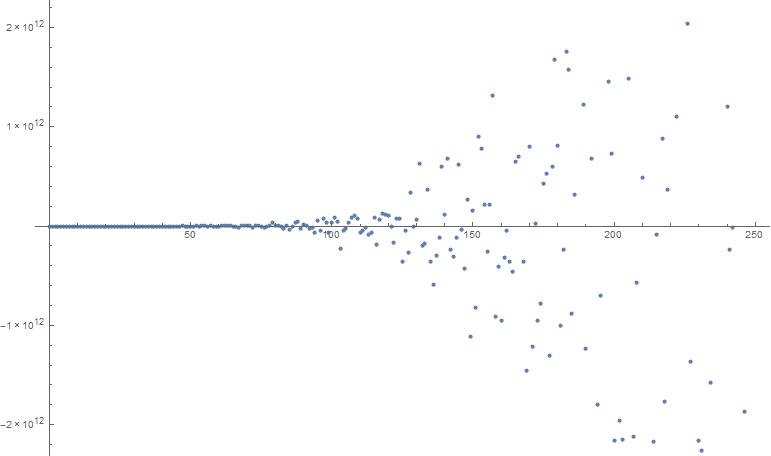Difference between revisions of "Ramanujan tau"
From specialfunctionswiki
(Created page with "The Ramanujan tau function $\tau \colon \mathbb{N} \rightarrow \mathbb{Z}$ is defined by the formulas $$\displaystyle\sum_{n=1}^{\infty} \tau(n)q^n = q \prod_{n=1}^{\infty} (1...") |
|||
| (4 intermediate revisions by the same user not shown) | |||
| Line 2: | Line 2: | ||
$$\displaystyle\sum_{n=1}^{\infty} \tau(n)q^n = q \prod_{n=1}^{\infty} (1-q^n)^{24} = \eta(z)^{24}=\Delta(z),$$ | $$\displaystyle\sum_{n=1}^{\infty} \tau(n)q^n = q \prod_{n=1}^{\infty} (1-q^n)^{24} = \eta(z)^{24}=\Delta(z),$$ | ||
where $q=e^{2\pi i z}$ with $\mathrm{Re}(z)>0$, $\eta$ denotes the [[Dedekind eta function]], and $\Delta$ denotes the [[discriminant modular form]]. | where $q=e^{2\pi i z}$ with $\mathrm{Re}(z)>0$, $\eta$ denotes the [[Dedekind eta function]], and $\Delta$ denotes the [[discriminant modular form]]. | ||
| + | |||
| + | <div align="center"> | ||
| + | <gallery> | ||
| + | File:Ramanujantau.png|Plot of $\tau(n)$ for $n=0,1,\ldots,250$. | ||
| + | </gallery> | ||
| + | </div> | ||
=Properties= | =Properties= | ||
| − | + | [[Ramanujan tau is multiplicative]]<br /> | |
| − | + | [[Ramanujan tau of a power of a prime]]<br /> | |
| − | + | [[Ramanujan tau inequality]]<br /> | |
| − | |||
| − | </ | ||
| − | </ | ||
| − | + | =References= | |
| − | |||
| − | |||
| − | |||
| − | |||
| − | |||
| − | + | [[Category:SpecialFunction]] | |
| − | |||
| − | |||
| − | |||
| − | |||
| − | |||
Latest revision as of 00:53, 23 December 2016
The Ramanujan tau function $\tau \colon \mathbb{N} \rightarrow \mathbb{Z}$ is defined by the formulas $$\displaystyle\sum_{n=1}^{\infty} \tau(n)q^n = q \prod_{n=1}^{\infty} (1-q^n)^{24} = \eta(z)^{24}=\Delta(z),$$ where $q=e^{2\pi i z}$ with $\mathrm{Re}(z)>0$, $\eta$ denotes the Dedekind eta function, and $\Delta$ denotes the discriminant modular form.
Properties
Ramanujan tau is multiplicative
Ramanujan tau of a power of a prime
Ramanujan tau inequality
